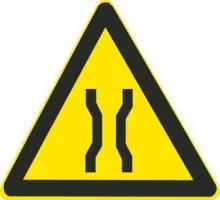1、Which lamp should be turned on when motor vehicles pass through a road section at night where the street light condition is good?
A、Front and rear fog lamps
B、Low-beam
C、High-beam
D、Hazard lamp
Answer:B
2、When a motorcycle is making a turn in a high speed, the driver should avoid using the brake or use the brake less to prevent sideslip.
A、Right
B、Wrong
Answer:A
3、If the vehicle has no license plate, label of inspection or label of insurance, preserve the scene and immediately report to the police.
A、Right
B、Wrong
Answer:A
4、What is the meaning of this sign?

A、continuous down slopes
B、steep downhill road
C、steep uphill road
D、continuous up slopes
Answer:A
5、What is the meaning of this sign?

A、no going straight and no changing to left lane
B、no going straight and no left turn
C、allowed to go straight and change to left lane
D、no going straight and no right turn
Answer:D
6、When driving on a foggy day, the driver should turn on the fog lamp.
A、Right
B、Wrong
Answer:A
7、When driving on a road covered with ice and snow, the motor vehicle may spin or slide when increasing the speed urgently, due to the loss of vehicle stability.
A、Right
B、Wrong
Answer:A
8、Which of the following is a basic requirement for rescuing the injured at the scene of a traffic accident?
A、Treat wounds first and safe life later
B、Save life first and treat wounds later
C、Help lightly wounded persons first
D、Help seriously wounded persons later
Answer:B
9、Driving a motorized vehicle on the road in violation of road traffic regulations shall be subject to relevant punishment.
A、Right
B、Wrong
Answer:A
10、After causing a road accident, the vehicle driver needs to change the scene for rescuing the wounded, the driver should mark the location.
A、Right
B、Wrong
Answer:A
11、After setting off from a roadside, motor vehicle drivers should watch both sides of the road, turn left and drive into the normal lane slowly.
A、Right
B、Wrong
Answer:A
12、What is the meaning of this sign?

A、bypass from left side
B、continuous curves
C、sharp left curve
D、sharp right curve
Answer:C
13、What is the meaning of this sign?

A、driving at reduced speed in the section of 40 meters
B、minimum speed is 40km/hr
C、maximum speed is 40km/hr
D、40km/hr speed limit ban is lifted
Answer:D
14、If the accumulated penalty points of a motorized vehicle driver reach 12 points and the driver refuses to participate in the study course and also refuses to take tests, it should be publicly announced that his driving license should no longer be used.
A、Right
B、Wrong
Answer:A
15、What is the meaning of this sign?

A、road narrows on the left side
B、narrow bridge
C、narrow road
D、road narrows on the right side
Answer:B
16、When encountering stopping and waiting in turn or slow-moving vehicles in front, the motorized vehicle may _________.
A、borrow road to overtake
B、occupy the opposite lane
C、follow the vehicles in front
D、cut in the waiting vehicles
Answer:C
17、When a motorcycle wades across the water, the braking efficiency of the brake does not change.
A、Right
B、Wrong
Answer:B
18、Overtaking is allowed when passing a level crossing in city where no train passes.
A、Right
B、Wrong
Answer:B
19、When use the brake of a motorcycle, use the front-wheel brake first, then use the back-wheel brake.
A、Right
B、Wrong
Answer:B
20、When a motorized vehicle runs in a foggy weather, the driver should turn on the fog light and the hazard lights.
A、Right
B、Wrong
Answer:A
21、If a driver finds there is no vehicle behind, he/she may change lanes without turning on the indicator.
A、Right
B、Wrong
Answer:B
22、A motorized vehicle driver who uses falsified and altered vehicle license is subject to a ________.
A、6-point penalty
B、3-point penalty
C、2-point penalty
D、12-point penalty
Answer:D
23、When running on the road having maximum speed limit signs, the motorized vehicle is not allowed to exceed the marked maximum speed.
A、Right
B、Wrong
Answer:A
24、When following other vehicles on a foggy day, what should the driver do?
A、Maintain a large safety distance
B、Turn on the high-beam
C、Turn on the low-bea
D、Sound the horn in due time
Answer:A
25、The behavior of a motorized vehicle driver who has violated the law and regulations on road traffic safety is _______ .
A、faulty act
B、violation of regulations
C、rule-breaking act
D、violation of law
Answer:D